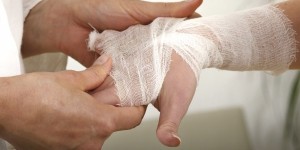We’ve been talking a lot about how to cope with different kinds of natural disasters and how to avoid being injured these past weeks, but what if it happens? What if you get injured and you have to deal with it with no medical assistance? Sometimes, knowing how to identify the wound is a matter of life and death in emergency situations. You have to know how to treat them accordingly or else you might have to deal with a serious infection or hemorrhage.
Fortunately, we live in an age where doctors spread a lot of useful information online, so I found out some pretty useful things in this area. The most important thing you need to know about an injury is how serious it is, and how much time can you stay without medical assistance.
Here are 10 signs that show you that you are dealing with a serious injury that needs a doctor’s attention right away:
- If the cut is deep, it will be 1-inch long on your members and 2-inch long on other parts of your body.
- If the cut is jagged, then you were probably bit by a cat or a dog. These kinds of wounds can get infected.
- If the cut is given by the bite of a wild animal, then the severity of it plus the viruses you might from the animal get can be serious.
- Generally, if your injury is caused by the bite of anything or anyone, you can never really know how bad it is until a doctor sees you.
- If you’re bleeding hard, you need a doctor to stop the bleeding from its source.
- If you have a minor bleeding problem, you can try to stop it but you are still bleeding after 10 minutes, then you need to see a doctor.
- If the wound is a puncture wound, a specialist should determine how serious it is.
Don’t think that just because you have a small wound, you don’t need a doctor. Sometimes the ones that don’t hurt or the small ones are the most dangerous.
Even if you are able to go to the doctor, you should take the first steps yourself – clean the wound with water and soap and pressure it for up to 10 minutes. If you can’t reach a doctor or he can’t reach you, ask a 911 operator to guide you through treatment.
If your injury is not big, then in a disaster situation you might not be a priority for the doctors, so you need to know how to take care of yourself.
Face Injuries
It is important to know the location of your wound in order to know what bandage to apply. Face cuts tend to bleed more than say, member cuts; clean the wound and pressure it with sterile gauze. Apply an adhesive strip if the wound is not that big or determine whether you need stitches – for cuts longer than half of inch.
Blisters
Usually, blisters repair on their own and don’t need special care. If, however, the wound is on your feet or your palms you will need to cover it with something soft for protection against rubbing.
I will continue with more advices on how to treat wounds in emergency situations next time!



No comments yet... Be the first to leave a reply!